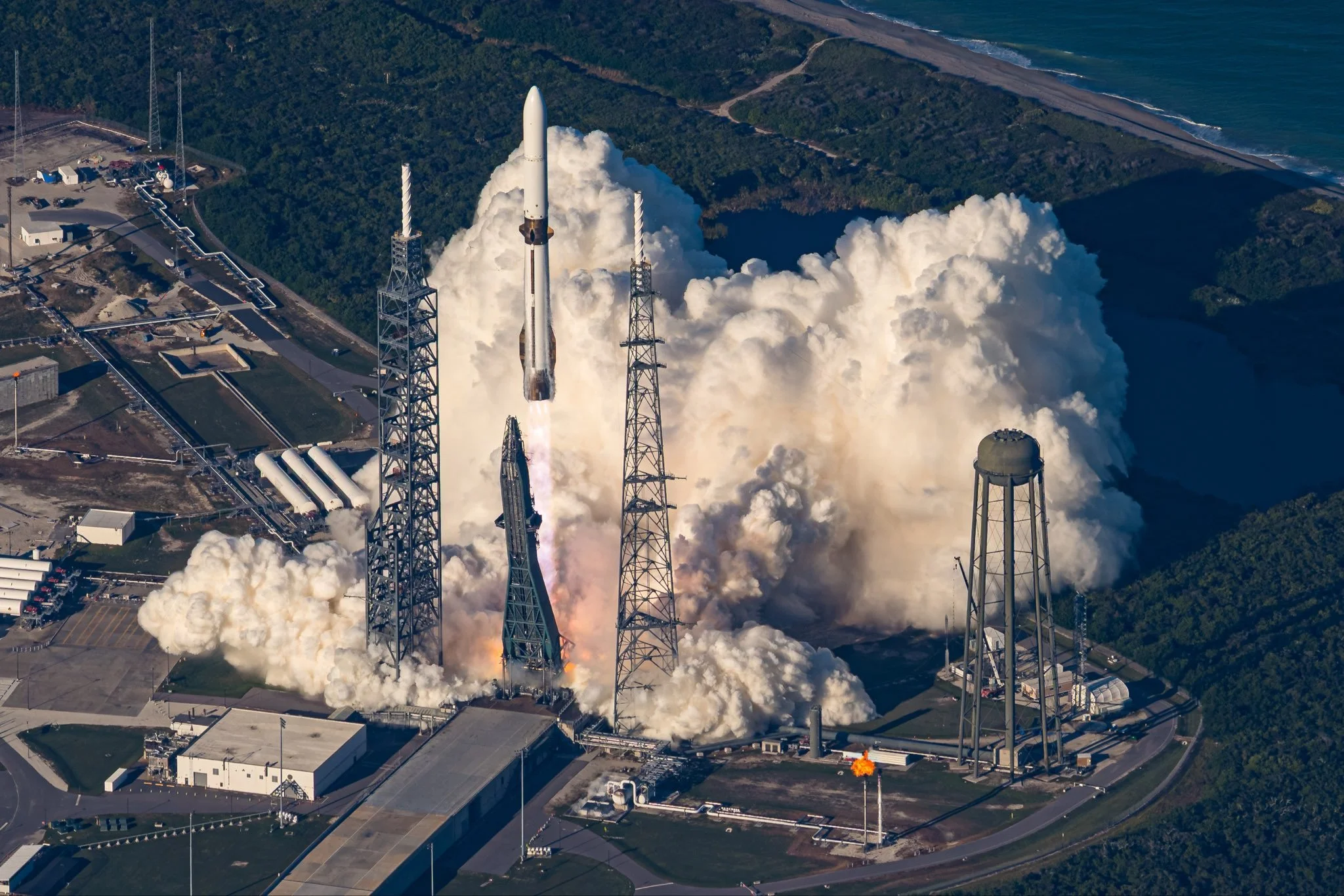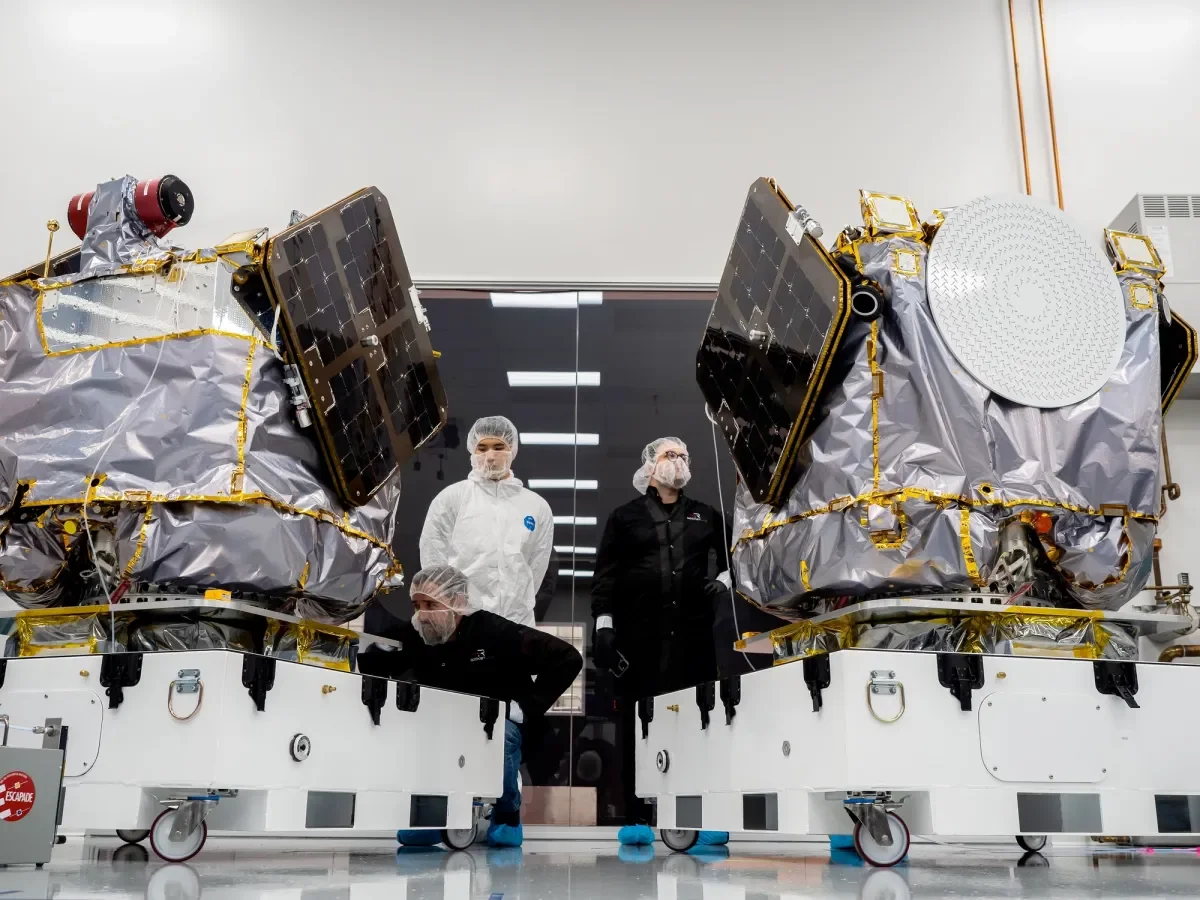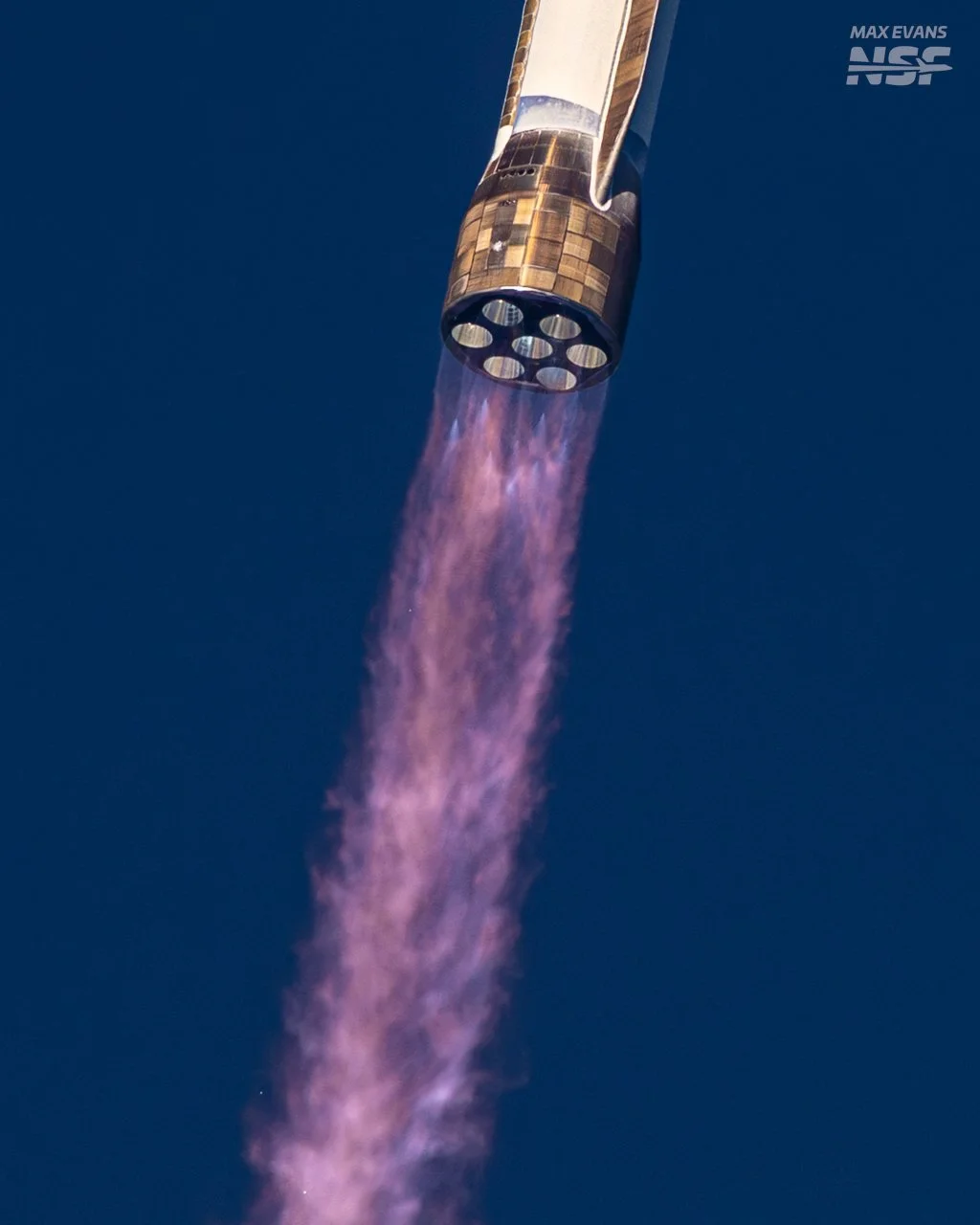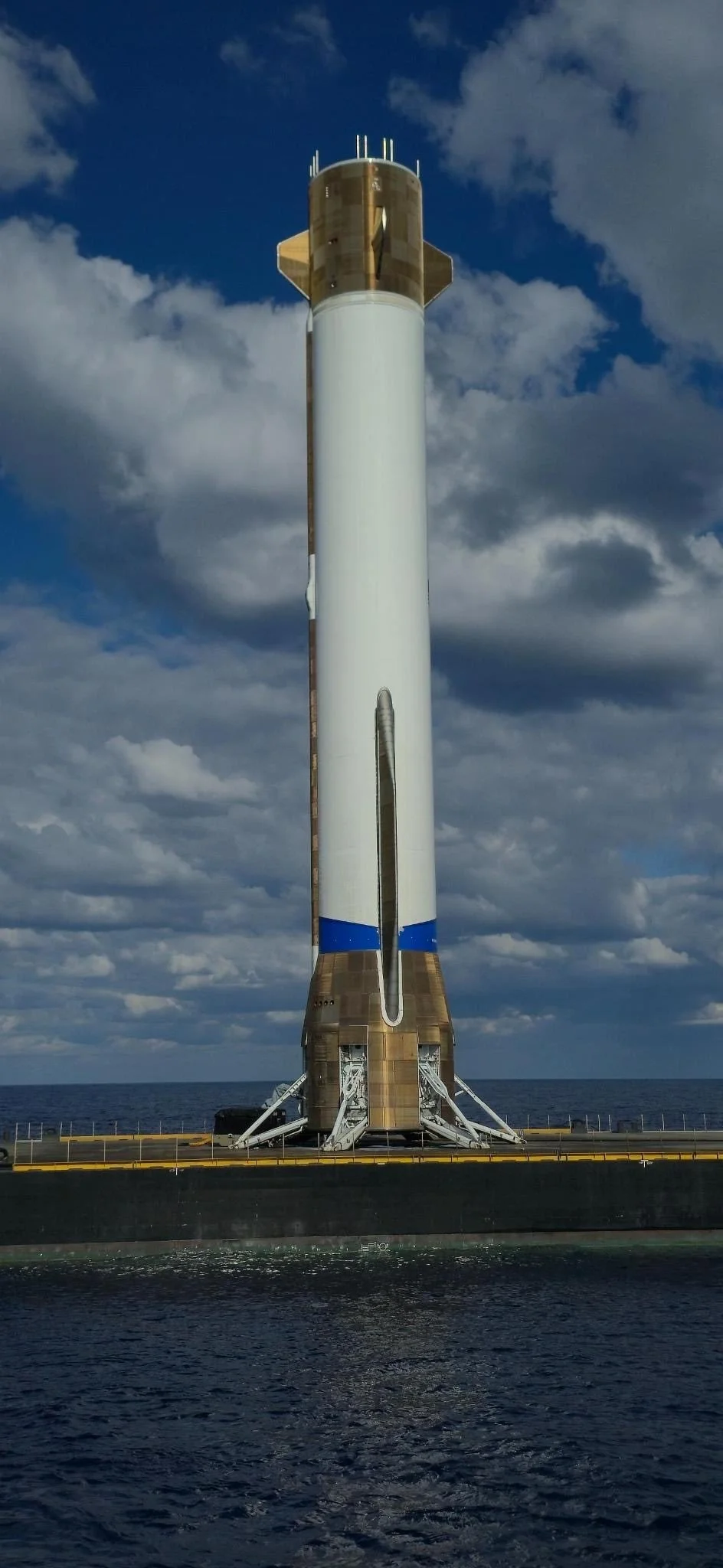New Glenn successfully launches ESCAPADE, nails historic landing
In the afternoon hours of Thursday, November 13th, Blue Origin launched its New Glenn rocket for the second time, reaching both main objectives: sending the ESCAPADE spacecraft to the L2 Sun-Earth Lagrange point and landing the first stage booster downrange; a secondary objective included testing a telemetry relay service from Viasat, which was a success as well.
New Glenn launching. Credit: Blue Origin
In case you missed our previous, in-depth article (which you can read here), here is a summary of the NG-2 mission objectives:
Launched by New Glenn, NG-2 marked the second launch for this next-generation rocket, developed by Blue Origin, which also places itself as one of the biggest rockets ever developed: 98 m tall and 7 m wide, this rocket is as tall as SLS, and its 7 BE-4 methalox engines on the first stage (GS1) provide a thrust of more than 17 million N.
The second stage (GS2), powered by 2 BE-3U hydrolox engines, has a thrust of 1.6 million N, with a great efficiency that allows it to burn for longer and carry a significant payload of 45 t to Low Earth Orbit (LEO).
Today’s primary payload was ESCAPADE, a mission composed of 2 identical spacecraft developed by Rocket Lab: Blue and Gold. These two spacecraft are designed to study the Martian magnetosphere, broadening our understanding of the magnetic environment on Mars, including its past history, its current conditions, and how future astronauts will be impacted.
A secondary payload was an array of antennas from Viasat, mounted on the second stage, which conducted a demonstration of their telemetry relay system.
Both ESCAPADE spacecraft. Credit: Rocket Lab
This was the second actual launch attempt for this mission: the first attempt, on November 9th, was delayed to the end of the launch window and then scrubbed at L-4m33s, ahead of terminal count, due to weather, range, and technical difficulties. This prompted Blue Origin to seek an exemption from the FAA’s launch curfew in order to be allowed to launch in their own window; this exemption was ultimately granted, and a new launch date was scheduled for November 12th. However, the launch attempt was scrubbed ahead of propellant loading due to high solar activity caused by a coronal mass ejection that led to a G4 geomagnetic storm.
Despite the uncertainty about the solar activity levels for the coming days, the company rescheduled the launch for the 13th, pushing ahead with a 97% chance of favorable launch weather, low risk of recovery weather issues, and moderate risk for the solar activity.
A story about the mission
Countdown
Propellant load began at about T-4h30m, starting with GS2 (Glenn Stage 2)’s liquid hydrogen (LH2); this was then followed by LOX (liquid oxygen) load for both stages at T-4h and by GS1 LNG (liquified natural gas, basically methane) load at T-3h30m.
At about T-1h, New Glenn completed propellant loading on all its 4 main tanks, and began to replenish said propellants to counteract natural boiloff… at T-17m, the GO/NO-GO poll ended with a GO for terminal count, starting at T-4m; final checks were being made, and the rocket was just 20 seconds away from lifting off before an automatic abort was called. This abort, of unknown nature, caused the T0 to be pushed from 19:57 to 20:45 UTC… the second time around, a hold was called just ahead of the GO poll for terminal count, causing the countdown to be pushed back another 10 minutes, but finally, on the third time, the GO poll was allowed to proceed into terminal count, and the rocket was ready for liftoff!
Mission
Water started flowing at T-16s, and the engines ignited at T-1s… finally, the rocket slowly lifted off the pad, under the power of all 7 engines at full thrust.
The power of New Glenn’s engines ripped through the sky as the rocket kept ascending upward and pitching downrange; about 1.5 minutes into flight there was Max-Q, or the moment of maximum aerodynamic pressure on the rocket.
New Glenn’s business end on ascent. Credit: Max Evans
After flawlessly going through Max-Q, several events happened in quick succession: first, the 7 BE-4 engines on the first stage shut off simultaneously, followed by stage separation. A few seconds later, both BE-3U engines ignited on the second stage, which began its journey to orbit, while the first stage began its brief coast phase, which brought it to 127 km before coming back down; as it followed its nominal trajectory, its RCS system was able to allow the stage to maintain a nominal orientation on all axes in preparation for reentry burn: this particular burn used 3 engines burning for 28 seconds between the altitudes of 67 and 45 km; this burn slowed GS1 down from 7500 km/h to 5040 km/h, allowing it to survive reentry in the thickest parts of the atmosphere without significant damage.
Following the reentry burn, the first stage kept descending while slowing itself down, thanks to the thickness of the atmosphere and its body causing drag; meanwhile, the strakes at the bottom were generating lift, guiding the booster towards Jacklin, and the 4 fins at the top were ensuring a stable descent.
And then, the moment came: under the cheers of thousands of employees and under the eyes of tens of thousands of people, the first stage ignited 3 of its engines at about 3 km of altitude and 1000-1250 km/h of speed; it slowed itself down using those engines while going through the clouds, and after about 20 seconds, it shut off both side engines and only kept the center engine lit. At this point, it used the single BE-4’s gimbaling and the RCS thrusters to put itself from inclined to vertical above the water, more than 100 m from Jacklin; here, it deployed its landing legs while hovering and translating towards the droneship, and once it was above it, it eliminated its horizontal velocity and started descending at 8 km/h, making a bullseye touchdown on the deck of Jacklin about 9 minutes into the flight!
GS1 landing burn startup. Credit: Blue Origin
This incredible and unexpected milestone marked the end of a decade-long monopoly where only SpaceX was able to land orbital-class boosters; it also marked an incredible feat of engineering, where Blue Origin was able to land such a massive rocket stage out at sea, with bullseye precision, on its second flight (and first landing attempt where they reached past the reentry burn); we have finally reached an era where more companies are attempting and succeeding in landing rocket stages, and we should be proud of all of them.
GS1 following landing on Jacklin. Credit: Blue Origin
Meanwhile, the second stage continued its flight for about 4 more minutes, reaching SECO (Secondary Engine Cut Off) at almost 27.000 km/h, putting the stage into orbit; here, it began a 10-minute-long coast phase before igniting its engines again for a 2-minute burn that accelerated it to 38.000 km/h, reaching escape velocity, and putting the spacecraft on a trajectory to L2. These spacecraft, Blue and Gold, separated a few minutes later, marking a full mission success.
GS2 leaving Earth. Credit: Blue Origin
The technology demonstration from Viasat also powered up a few minutes after main payload deployment and lasted for about 1 hour before the mission was ended, with the second stage ending up in a heliocentric orbit.
References
Replay: New Glenn Mission NG-2 Webcast
Blue Origin (@blueorigin) / Posts / X





